Categories: Featured Articles » Electrician at home
Number of views: 32752
Comments on the article: 1
How to supply electricity to outbuildings in the country and in a private house
Owners of cottages and summer cottages on their territory are building garages, baths, small workshops, cellars and other utility rooms, which are supplied with electricity for lighting, heating and other uses.
The article gives recommendations on how to reliably and safely perform such work, avoiding the typical mistakes made by home masters.
Principles of designing a power supply scheme for a building
Before undertaking electrical work, they must be carefully thought out and a plan drawn up on paper. This will save time on the implementation of ideas, materials and money.
Power grid structure
Official sources recommend using a radial wiring diagram in new rooms to the main distribution panel of the building when cable lines radiate to all consumers from it.

This option allows you to have all the protections and circuit breakers in one place, which is convenient to perform according to the calculations of the laws of electrical engineering. But, in practice, it is required to lay a large number of highways, and this leads to increased cable consumption.
An alternative to the radial method of laying highways is a tree structure.
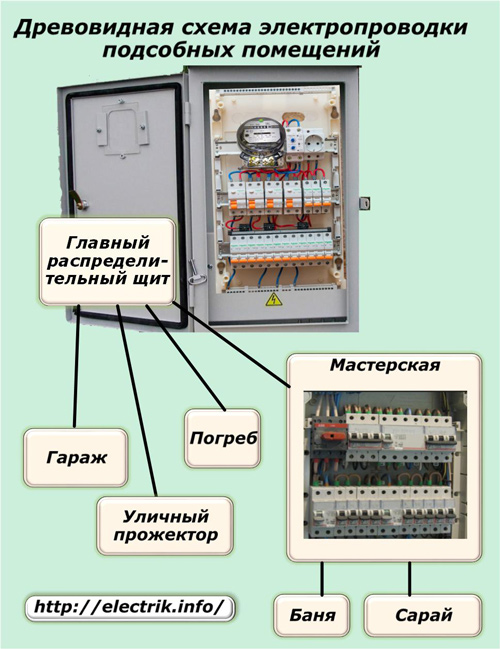
Here, electricity from the main switchboard of a building can be supplied not only individually to each consumer, but also to certain groups of them. For example, the electrical equipment of the bathhouse and barn, which are located near the workshop (and they are used less often), can be connected to automatic machines and protections located in the electrical panel of the workshop.
The tree-based method allows you to build a more convenient structure for the owner of the hierarchy of consumer power, save cable.
Electrical panels can only be installed in dry, enclosed spaces that ensure safe operation. In a bathhouse, in a damp basement, it is dangerous and forbidden to use them.
Inside technical rooms, they usually create separate power supply with protections for power circuits and lighting installations, connecting them with a separate cable. This allows you to split the power circuit and leave the lighting in the room when an accident occurs and turns it off, for example, due to a short circuit on the charger of car batteries: the owner does not have to look for a malfunction in the dark.
Wiring type selection
Wires and cables can be laid:
1. open method:
2. Inside walls, ceiling or floor.
In technical buildings, they usually use an open method of laying wires along walls, placing them at a safe distance. This simplifies installation, eliminates the need for the need for strobing building structures.
Walls and ceiling of building wood premises allow quick installation of wires in retrostyle using rollers. An alternative to this method are modern cable channels. They are quickly and conveniently mounted, all electrical wiring elements are closed.
Placing the cables inside the walls creates their best protection against possible mechanical influences.
The choice of method for supplying electric power lines
The voltage to the electrical equipment of the outbuildings must be performed reliably and as safely as possible. It can be summed up:
-
wires over the posts of the overhead line:
-
cable laid inside the ground.
The location of the cable on poles or walls is also used, but as an exception.Applying voltage to structures like temporary extension cords, which are constantly unwound and assembled, can cause electrical injury.
Drawing up a plan for the placement of electrical appliances in the utility room
Before visiting a store selling electrical equipment, you should think over the distribution places for electrical appliances, specify the number of illuminators, outlets for powering portable and stationary appliances, junction boxes. Their places need to be marked on the building elements of the building and accurately measure all distances.
This will help determine the length of cable required for acquisition. Performing the calculation, it is worth creating a reserve: at each junction of the wires, for laying and connecting the ends, it will be necessary to increase their length by 10 ÷ 15 cm. And the resulting total amount will need to be increased by another 10 percent - this will provide a margin for the arising bends.
How to bring electricity to the building
Electric power input can be done:
1. by air;
2. underground.
Air inlet
For the first method, you will need to have a pillar at a distance of 25 meters from the building. A pipe stand with insulators on which wires are suspended is installed near the entry point. The place of their insertion into the pipe bent down must be performed in such a way as to prevent ingress of atmospheric precipitation.
When installing a pipe stand, durable fasteners and braces are used. The general design of the input must withstand natural factors: strong wind loads, icing.
To pass wires through the wall, it is recommended to maintain the building dimensions shown in the picture.
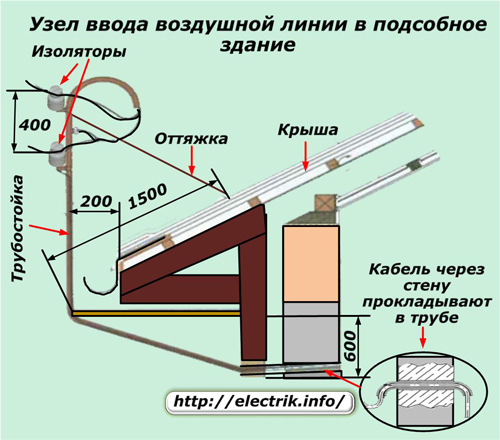
When using self-supporting SIP conductors, special anchor devices are used for their fastening.
See also: Laying the cable through the air in the country
Cable entry
For this method, you will need to dig a trench in the ground to a depth greater than the thickness of the freezing of the soil in winter. Otherwise, when a soil deformation occurs from the action of frosts, a mechanical effect on the cable and its destruction can occur.
When passing through the wall of a building, a metal strong pipe is used. The cable inserted through it is separated by a layer of thermal insulation. It is sealed with construction foam or other fillers, covering the internal cavity from moisture, damage by mice.
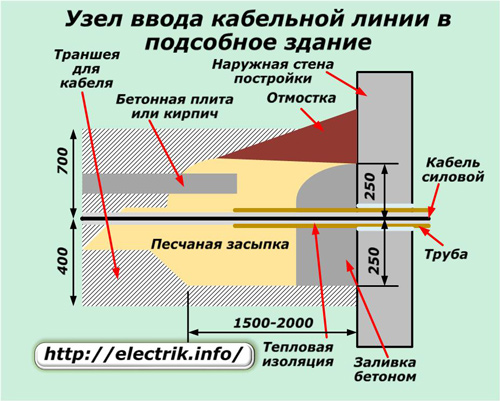
Sand backfill creates favorable operating conditions, and a concrete slab or brickwork from above protects against possible mechanical damage during future accidental excavations.
Cable laying in the ground
When storing and transporting cable drums, surface layer or core insulation may be damaged. Work with polyvinyl chloride coatings at negative temperatures is prohibited due to the appearance of microcracks in them that occur during bending. Such defects in the insulation layer break the integrity of the dielectric and completely damage the cable products.
Therefore, the cable delivered to the installation site should be checked by electrical measurements for insulation integrity before installation. You can take measurements with a special device - megaohmmeter.
The resin-impregnated armored sheath is designed to protect power cables placed inside the trenches from accidental mechanical stress. When it is not, then metal, asbestos-cement or PVC pipes are used for laying.
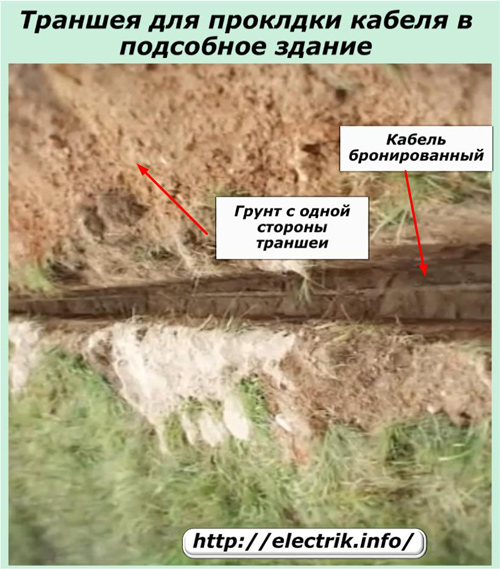
The route of the trench should be chosen so that it does not intersect with other utilities (gas, water, telephone, heat, etc.). If on the route there are sections with decorative paths, beautiful plants, a lawn, which it is desirable to leave intact, then through them you can make a puncture in the soil.
To do this, it is enough to dig a trench on both sides of such a site and use a pipe and a sledgehammer to break through the thickness of the soil between them.A cable is inserted into the hole formed, and the topsoil remains intact, is not subject to destruction.
At the bottom of the prepared trench, a layer of sand of 15 cm is poured, moistened and rammed to a thickness of ten centimeters. All large stones that may damage the pipe over time must be removed. The cable is laid on a well-compacted and aligned base.
Pipes for cable are assembled end-to-end through special plastic connectors. They hermetically close the joints and prevent sand and other debris from getting inside, which can damage the outer shell during installation or operation.
After the pipes are laid and a cable is placed on them, plastic plugs are installed on the ends of the walls, and sand is again poured on top with a layer of 15 cm and rammed up to 10 cm. In this way, the cable in the pipeline (or armored) is placed in a dense layer of sand.
Next, the trench is filled to half the depth with excavated soil and a signal tape or layer of bricks is laid on it, which is designed to inform people about the presence of cable during future excavations.
If the length of the trench is relatively small, then a simple cable can be placed in it even after installation and backfilling of the laid pipe. This is done by pulling a steel rigid cable or wire of thick cross section, which is shoved through the entire highway so that its ends protrude from both sides.
From one end of the wire rod, the cable is fixed by piercing the sheath in one place and tightly tied with a layer of adhesive tape or tape. And then the cable is pulled into the pipe by the protruding end of the wire. On the reverse side, you should watch its movement on the ground, avoid contact with sharp objects, avoid overflow, the formation of nodes.
General lighting of the territory
To illuminate large areas with outbuildings, powerful lamps are used in a sealed enclosure, which are placed at a sufficient height.

The use of self-supporting wire structures for their supply increases the safety and reliability of use.
Features of wiring in a workshop or garage
When laying on the walls, the cable lines are only vertically or horizontally rotated at right angles. Sending them obliquely to save length is not accepted.
Removing electrical wiring 10-15 cm from the ceiling along the top of the wall is best suited for security purposes. If on the way there are heating lines, then they are not approached closer than 15 cm.
In the garage and workshop, it is customary to install lighting switches near the front door at shoulder height, and sockets - about 60 cm, taking into account local conditions. The power supply lines should be separated by separate streams, protected by circuit breakers and RCDs located in the garage electrical panel.
When an inspection pit is used inside the garage, a switch is installed outside the zone to illuminate it, and the lamps are used in a moisture-proof design. To power them, an isolation transformer with a voltage of 12 volts is used. This is dictated by the formation of increased humidity at the floor level under adverse conditions.
Open wiring is recommended to be closed inside the cable channels, as shown in the photographs below.
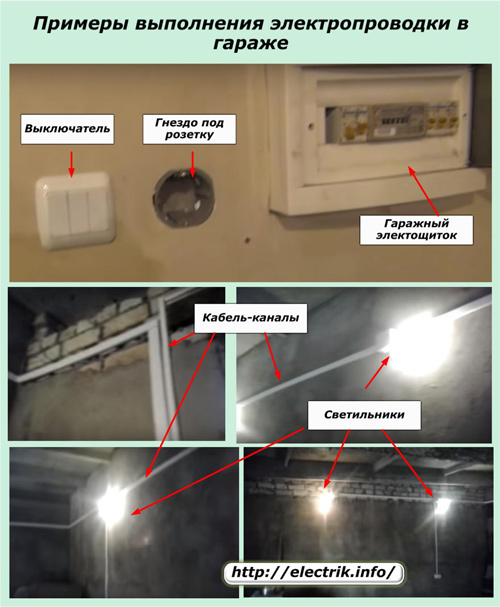
The cross section and material of the cable wires must correspond to the connected load.
Basement wiring
Inside underground structures, the operating conditions of an environment with high humidity are always taken into account. Therefore, they do not place switchboards, switching devices and sockets. Switches for lighting are installed at the entrance to the basement from the street.
Lamps are used with a protective metal cap and a durable bulb made of thick glass. All seals are reliably sealed with special gaskets.
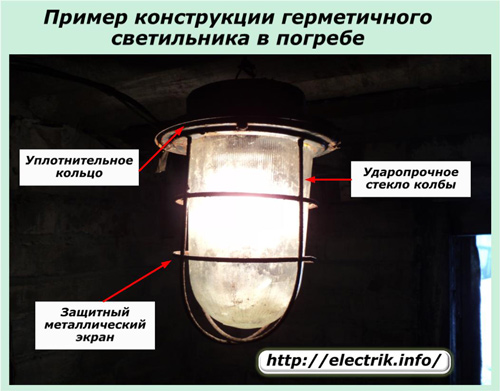
Basement lighting protection devices are located inside branch shields.
Laying electrical wiring in the bath
According to the degree of safety, the interior of the bathhouse is classified into four classes, requiring the use of different rules for the use of electrical wiring.
Installation of sealed fixtures with a high degree of protection against ingress of water splashes and vapors can be performed beautifully by enclosing them in decorative housings.
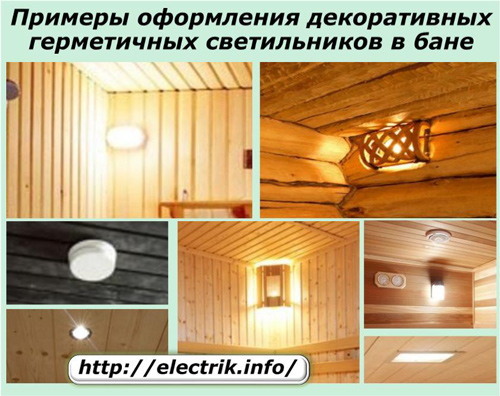
Particular attention should be paid to cable construction. In a steam room, it is exposed not only to high humidity, but also to temperature. For her, it is recommended to use the stamps:
-
multi-wire flexible copper wires PRKA, RKGM, PVKV, PRKS, allowing operation up to 180 degrees;
-
single or multiwire conductors of the PMTK brand, designed to operate at 200 degrees;
-
OLFLEX HEAT 205 cable - 200 degrees.
They have a fiberglass braid impregnated with heat-resistant varnish or enamel, covering the insulation of organic rubber with increased strength.
In the rest room and vestibule, it is allowed to use a conventional cable of the VVGNG-LS type or its analogues. Posting can be done open or closed.
However, it is forbidden to place wires inside metal pipes due to high humidity, as well as cables in metal sheaths.
Sockets for connecting portable devices are not allowed to be installed in the steam room, and in the vestibule and relaxation room it is completely allowed.
To perform wiring in the bath, you can use a household single-phase 220 volt network. But, for this it is necessary to observe the conditions:
1. the power supply line of the bath should be protected by a differential machine or RCD;
2. connection completed via TN-S or TN-C-S using a potential equalization circuit.
If it is difficult to solve these conditions at the same time, then they are powered by a 12, 24 or 36 volt isolation transformer.
In each specific case, it is necessary to power the utility rooms in such a way as to ensure the safety and reliability of electrical equipment. Therefore, with self-assembly, you should think carefully about the upcoming technology and get advice from qualified electricians.
The final installation phase prior to commissioning is considered responsible. Before applying voltage to the assembled circuit, it must be checked by electric measurements for the possibility of short circuits and the state of insulation, ensuring the absence of leakage currents.
See also at bgv.electricianexp.com
:
